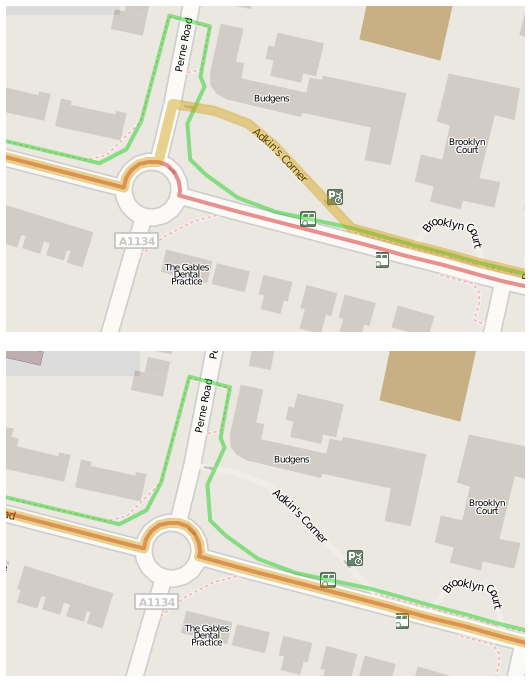The graphic shows work in progress to improve the quality of CycleStreets routes by taking into account the cost of making a turn.
This is part of routing enhancement work being undertaken by Codex Cambridge with us as part of the Technology Strategy Board Innovation Vouchers scheme.

Bottom: by including turn cost the advice changes to straight on at the roundabout.
The upper frame shows three routes for a journey along Cherry Hinton Road, Cambridge from west to east. The quietest route in green avoids the busy roundabout by using the shared use footway and toucan crossing of Perne Road. The fastest route in red goes straight across the roundabout. The balanced route shown in amber takes the first roundabout exit and then uses the service road marked Adkin’s Corner to connect with the shared use pavement.
The problem with the balanced route is that it is rather awkward to make that right turn off Perne Road. A rider willing to make such a right turn would likely be equally confident to have gone straight on at the roundabout.
Turning right from a major road into a minor road usually requires looking behind and moving out into the road to get into the right position to make the turn. If there is a lot of traffic it may require stopping at an arms distance from the middle of the road and waiting until it is safe to complete the turn. These factors amount to an extra delay and make the route feel more busy.
The lower frame shows the situation when the cost of making a turn has been included in planning the route and shows the balanced route going straight on at the roundabout.
Choosing the numbers
In the case of the fastest route the cost of turning right can be estimated as a number of seconds. The estimate has to be for a typical rider and represent an average time. In reality the amount will vary by the time of day, amount of traffic, the type of roads involved and the rider. In CycleStreets the only data we can easily access are the types of road. So as a starting point we can create a table with the following columns:
- from road type (e.g. primary, secondary, service)
- to road type
- turn type (eg. turn left, turn right, straight on)
- estimated delay in seconds
So for instance a right turn from a primary road into a service road could have a delay of eight seconds, whereas a left turn from a residential road to another residential road might have only a one second delay.
Turn delays in seconds only affect the fastest routes, and have no affect on the quietest routes which are only concerned with how busy the route. To account for turns in quiet routes involves comparing a right turn with an equivalent cycling distance. Eg. are you prepared to cycle for an extra 100 metres to avoid a right turn off a busy road into a service road?
Choosing the right numbers for that is a bit of an art and a lot of experimentation. This is work in progress, and there’s a bit more to do before we can include this in CycleStreets routes.
5 thoughts to “How far would you ride to avoid a busy right turn?”
You might find this research for TfL (released via FOI) interesting: https://www.whatdotheyknow.com/request/143729/response/398827/attach/3/Final%20report%20CRC.pdf
They use a stated preference approach to identify how much time cyclists are willing to add to their journey to avoid particular kinds of turns and junctions. For example: “On average respondents were prepared to add 7.5 minutes to their most recent journey to avoid a right turn at a two lane roundabout or a right turn from a side road onto a main road”.
Also notale that willingness to trade large amounts of time for safer routes was higher for women, older people and less frequent cyclists.
Gosh, I am surprised at that additional amount of time. I was thinking in seconds, not minutes.
As a reasonably confident rider who always picks the fastest option, the biggest factor in terms of time when it comes to new routes is how much I spend stopping and checking my phone for where to go next, and how.much time spent working out how to get back on route after missing a turning etc. The more turns there are, the less I can remember the route, I have to check my phone more.frequently, and the more likely I am to go wrong. So I am always willing to cycle a few hundred metres more to have a simpler route that I can execute quickly. It’s harder to see signs on roads that are right turns, this makes them easier to miss.
If there was a “simplest” option I’d probably use it the most.
Si,
Yes, me too. But the methodology looks fairly sound. And bear in mind that their sample ranged from frequent and confident cyclists to infrequent and unconfident ones. So whereas confident cyclists might go out of their way only a matter of seconds to avoid a particular kind of junction, less confident ones might find it very hard to envisage *ever* using that kind of route and would therefore put a very high time value on avoiding it.
For the purposes of Cyclestreets it raises the interesting question of whether the calculations should be based on the ‘typical’ more confident London cyclist or also incorporate the bigger group of marginal, less-confident types.
Commuting by recumbent bike, I actually do this often (except, of course, that we drive on the other side here in Denmark). A recumbent is less maneuverable than an upright bicycle and looking back over one’s shoulder is difficult and for low riders like mine almost impossible, making turns across the street less desirable. I’d rather go a bit further maintaining speed than stopping to orientate. Interesting study, actually.